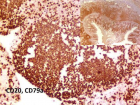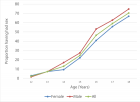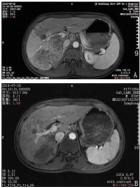Table of Contents
A case report of an Erdheim-Chester patient focused on pain management
Published on: 12th September, 2019
OCLC Number/Unique Identifier: 8253091607
Introduction: Erdheim-Chester disease (ECD) is a rare and difficult-to-treat non-Langerhans cell histiocytosis characterized by the excessive production and accumulation of histiocytes. This study reports a case of ECD, emphasizing both its diagnosis, assessment and treatment of the pain associated with the disease.
Case Report: Six years ago, a 39-year-old male patient presented with generalized pain of moderate intensity in the lower limbs that involved periods of greater intensity associated with ambulation. The diagnosis of histiocytosis associated with panhypopituitarism and adrenal insufficiency was proposed. For a specific diagnosis, a bone lesion biopsy was performed, revealing the presence of histiocytic proliferation that was CD1 negative, S100 protein positive, and CD68 negative. Therefore, the diagnosis of non-Langerhans histiocytosis known as ECD was confirmed. During the two years that followed, the patient presented with severe bone pain, particularly in the lower limbs and cranial vault, and the pain subsided to a certain extent with the use of tramadol and paracetamol. Because of the pain, the patient was unable to walk and became bedridden As the patient remained in severe pain, even after the administration of morphine, the opioid was changed from morphine (60mg/day) to oxycodone (30mg/day) for a convenient dosing schedule; furthermore, the oxycodone dosage was scheduled to increase to 40mg/day that same week. The patient experienced significant pain reduction, requiring rescue analgesia only once or twice a week.
Conclusion: To the best of our knowledge, this is the first case report on the characterization and treatment of pain specific to ECD, and we highlight that the patient had a good response to treatment.
Essential thrombocythemia: Biology, clinical features, thrombotic risk, therapeutic options and outcome
Published on: 2nd September, 2019
OCLC Number/Unique Identifier: 8216107596
Essential Thrombocythemia (ET) is currently classified as a Philadelphia negative myeloproliferative neoplasm (MPN) together with polycythemia vera (PV) and primary myelofibrosis (PMF); the latter can be further divided in pre-fibrotic primary myelofibrosis (pre-PMF) and overt myelofibrosis, as listed in the revised 2016 World Health Organization classification of myeloid malignancies (WHO 2016). Overall, respect to the others MPNs, ET is characterized by favorable prognosis, lower life expectancy if compared to the control population, increased risk of thrombohemorrhagic complications along with possible evolution in myelofibrosis and leukemic transformation. In this review the authors will review current knowledge on biology, clinical aspects, prognosis and stratification of thrombotic risk, therapeutic options and outcome in ET patients.
Relation of Arachnophobia with ABO blood group system
Published on: 8th August, 2019
OCLC Number/Unique Identifier: 8212851418
In 1901, ABO system of blood groups was determined by Karl Landsteiner. It is present in different organisms like rodents, primates that includes chimpanzees, bonobos etc. The blood groups type in this system depends on some genes that are specific ABO gene. Arachnophobia is the dread of creepy crawlies and different creature like spiders. Individuals suffering from arachnophobia generally feels uneasy in any place where they accept that they could harbour arachnids or their existence for example, webs. 100 samples of blood from volunteers were used for Blood group test. The Blood groups were tested and results were recorded after the test all the used kits were discarded. The results shows that there is no clear cut difference between the arachnophobic males and non-arachnophobic male’s percentages, so no relation found in males. Similarly, in females both phobic and non-phobic ladies have no differences in their result values so, no relation was found. Whereas, in case of arachnophobic males and females comparison no relation was found. So, there is no relationship between ABO blood group system and arachnophobia and there may be a relation between non-phobia and AB+, B+ blood group in males whereas, in females only B+ blood group have relation with non-phobia.
The beneficial effects of varicella zoster virus
Published on: 15th July, 2019
OCLC Number/Unique Identifier: 8186245399
Varicella zoster virus behaves differently from other herpes viruses as it differs from them in many aspects. Recently, there has been growing evidence on the beneficial effects of the virus in immune compromised hosts and these effects are translated into prolongation of survival. The reported beneficial effects of the virus include: (1) stimulation of bone marrow activity in patients with hematologic malignancies and bone marrow failure syndromes, (2) antitumor effects in various hematologic malignancies and solid tumors, and (3) association with graft versus host disease which has anticancer effects. Additionally, there are several reports on the safety of the live-attenuated even in severely immune suppressed individuals and on the emerging role of the virus in cancer immunotherapy. In this review, the following aspects of the virus will be thoroughly discussed: (1) new data on the genetic background, pathogenesis, vaccination, and new therapeutic modalities; (2) bone marrow microenvironment and hematopoiesis; (3) cells involved in the pathogenesis of the virus such as: mesenchymal stem cells, dendritic cells, natural killer cells, T-cells and mononuclear cells; (4) cellular proteins such as open reading frames, glycoproteins, promyelocytic leukemia protein, chaperons, and SUMOs; (5) extracellular vesicles, exosomes, and micro-RNAs; and (6) signaling pathways, cytokines, and interferons.
Varicella zoster virus: The potentially useful virus
Published on: 5th July, 2019
OCLC Number/Unique Identifier: 8174826530
Varicella zoster virus (VZV), a double-stranded DNA virus, is a highly contagious human neurotropic virus that belongs to the alpha group of herpes viruses [1-4]. Primary VZV infection (chickenpox) occurs in childhood then the virus becomes latent in the nerve ganglia [1,5-7]. Reactivation of the virus may occur decades later and cause herpes zoster (HZ) which is manifested by a typical painful skin eruption that has characteristic dermatomal distribution [1,5]. Reactivation of VZV is usually predisposed to: old age; comorbid medical conditions such as diabetes mellitus, chronic obstructive airway disease, and end-stage renal disease; and immunosuppression due to malignancy, autoimmune disorders, immunosuppressive therapies, trauma, cytotoxic chemotherapy, hematopoietic stem cell transplantation (HSCT), and solid organ transplantation (SOT) [1,5-7].
Reversal of pure red cell aplasia by varicella zoster virus infection
Published on: 3rd May, 2019
OCLC Number/Unique Identifier: 8163589934
Background: Pure red cell aplasia is characterized by anemia, reticulocytopenia and diminished bone marrow erythroid precursors. It has multifactorial etiology and consequently several therapeutic interventions.
Case: In August 2017, a young patient was diagnosed to have pure red cell aplasia. She was given immunosuppressive therapy for approximately two months but this treatment was stopped due to intolerance. Later on she developed herpes zoster infection that was treated with valacyclovir. Subsequently, it was noted that the patient became blood transfusion independent due to normalization of her hemoglobin and regeneration of the erythroid precursors in the bone marrow.
Discussion: Varicella zoster virus behaves differently from other members of the herpes group of viruses such as cytomegalovirus and Epstein-Barr virus. Two retrospective studies, performed in patients with malignant hematological disorders and bone marrow failure, have shown that infection with the virus may cause stimulation of the three cell lines in the bone marrow and superior overall survival.
Conclusion: The outcome of the patient presented confirms the findings of the two studies showing long-term beneficial effects of varicella zoster virus infections in immunocompromised individuals.

If you are already a member of our network and need to keep track of any developments regarding a question you have already submitted, click "take me to my Query."



















































































































































